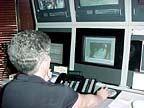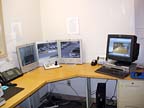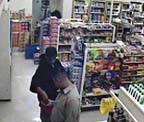

Bank integrates video and intrusion protection for Immediate Alarm Verification`
MidFirst Bank of Oklahoma City, which has more than 60 locations throughout Oklahoma, is in the process of upgrading videocassette recorder (VCR)-based systems in each location with digital video recorder (DVR)-based ones. It has benefited from adding remote video surveillance.The DVR systems that have been installed so far are connected to an in-house monitoring facility at corporate headquarters that is manned 24 hours a day. The upgraded systems also are integrated with the bank’s intrusion protection system.
The bank had three goals in making the upgrade. First, it wanted better image quality. Second, it wanted longer recording time and to eliminate the need for a manager at each site to install a new videotape every day.
It also did not want to maintain an archive of at least the last two months of tapes. Finally, it wanted the ability to remotely monitor each location.
The quality of the new digital system enabled the bank to achieve the first goal easily, reports Jerick Henley, president of Dowley Inc., Oklahoma City, the company handling the upgrade for the bank. “It increased the recorded resolution well above what they were doing with analog,†Henley notes.
Longer recording time was achieved by using a terabyte hard drive at each location coupled with internal motion detection, which can be programmed on a per-camera basis using equipment from GE Security.
Cameras at automatic teller machines are programmed to record on motion 24 hours a day. Others, such as those in the lobby or at teller locations, record on a time-lapse basis, using the highest frame rate per second at teller locations.
Because the system is tied in with the bank’s intrusion protection system, Dowley was able to increase the recorded frame rate of appropriate cameras to the maximum when a motion detector is tripped after hours or if a teller activates a silent panic alert. By tailoring the recording rate in this manner, the bank is able to retain 75 to 95 days of archives on each hard drive.
Integrating the bank’s intrusion protection and video surveillance systems also enables personnel at the remote monitoring station to know immediately when an alarm has occurred and enables them to look in on the branch, visually verify alarms and promptly dispatch the police.
Although bank personnel are reluctant to provide details, Henley asserts, “The ability to view high-resolution images across the network has increased their ability to investigate and react.â€
National Bank emphasizes facial recognition
When John Dickerson joined Sun National Bank as director of security in 2003, one of his credentials was 25 years with the New Jersey State Police, where he helped spearhead surveillance regulations for the Atlantic City casinos that helped lead to 2,000 annual arrests on the casino floors. Those surveillance regulations, which were instituted at the request of the state police, required casino owners to record facial images of casino patrons at every transaction area.At Sun National Bank, Dickerson has begun transitioning the bank’s 78 locations from a videocassette recorder (VCR)-based surveillance system to one based on digital video recorders (DVRs) with an emphasis on facial identification. “Along with upgrading our CCTV recording capability, I was able to prove that restitution would increase because police would more readily accept our cases and take them through prosecution,†Dickerson asserts.
At the onset of the project, Dickerson ranked the 78 bank branches in descending order by how much they could benefit from a system upgrade. Then he enlisted Deterrent Technologies, Ocean, N.J., to begin the conversion. Dickerson chose Deterrent because, along with access control, the company’s main focus was video surveillance, and its customers included several major banks.
Dickerson also had excellent rapport with Ken Leon, Deterrent Technologies account executive.
“I found a guy in Ken Leon who spoke the same language that I did,†Dickerson relates. “We’re on the phone once a day, and if I need them, within two to three hours they have a truck at the branch, even if it’s in another state.â€
As each branch is converted, a networked 16-port DVR with 12 to 16 cameras connected to it is installed. Great care is taken in selecting lenses and positioning the camera at each teller location so an image of each customer’s face can be obtained, even if he or she is wearing a hat.
This means installing cameras lower and slightly to the left or right of where customers traditionally would be located. Although this means the cameras are not hidden, that does not concern Dickerson.
“We want people to see the cameras,†he points out. “Prior to 9-11, the mentality was that people didn’t like Big Brother, but now there’s a comfort level in people seeing one-to-one cameras and tellers.â€
Dickerson rates the pictures as generally good enough for police to detain a suspect. The photos play a big part in prosecution at trials, a capability that already has been used in the first year of operation.
Another advantage of the system upgrade is that because the new DVRs are interconnected over the bank’s wide area computer network, it is easy for the bank to send images of suspects to other branches and to authorities.
“The advantage of digital recording is that you can search by teller transaction, ATM transaction or by time and date and immediately call up that position,†Leon of Deterrent Technologies notes.
Dickerson adds, “With a VCR, you begin to lose image clarity from the first copy. With digital, you can reproduce and enlarge photos with very little degeneration in clarity, which is very important with facial identification.â€
The DVRs in the Sun National Bank system record on a time and motion basis beginning one hour before the bank opens until one hour after it closes. During that time, cameras record continuously at one image every 10 seconds, increasing to the full rate of 30 images per second whenever motion is detected.
When the bank is closed, the system records only when motion is detected. Using these parameters, the bank is able to retain at least 90 days of archives at all times.
The upgraded video surveillance system has had non-security-related benefits as well. Managers with the proper authority can look in on cameras throughout the branches from their personal computers and have used that capability when an individual branch has asked to hire additional tellers.
“Management can watch and verify the customer traffic patterns,†Leon points out. “Maybe they need to hire someone – or maybe they just need to change the tellers’ hours.â€

Convenience store chain wins with two-way audio
Convenience stores that are open 24 hours a day can be particularly challenging to protect. It may not be enough to guard against late-night robberies – parking lots also can become crime scenes for drug deals and other illicit activities.One major convenience store chain has had great success in protecting its most troublesome locations by using a remotely monitored video surveillance system with two-way audio capability.
If there is a problem, an employee can push a panic button and within five to six seconds, images from the store are displayed on plasma screens and audio can be heard at the remote monitoring station, which is usually connected over a digital subscriber line (DSL).
One of the operators at the monitoring station then identifies him or herself and asks what the problem is. The employee can just talk from wherever he or she is located within the store and the sound of his or her voice can be picked up.
In a typical scenario, the store clerk might complain, “There are some teenagers out in the parking lot causing trouble.†The central station operator then would check them out on the outdoor camera system and activate the audio, asking the teens to leave.
“Usually they get in their car and take off,†maintains Dennis Colligan, national sales manager of retail for Navco Security Systems, Anaheim, Calif., which installs the two-way systems for the retailer.
If troublemakers show no signs of leaving after approximately 30 seconds, the central station operator advises them that they are trespassing and that the police are being called. “We get pretty good pictures and descriptions,†Colligan reports. “The police love it.â€
A typical convenience store two-way system includes six or seven cameras and three audio zones, one in the store and two outside. Stores usually measure approximately 3,000 square feet, which can be covered easily with a single audio system, Colligan notes. Although most stores already have some form of video protection, “We go in and beef up the system,†Colligan explains.
SentryCom Inc., which monitors the system for Navco, is staffed by many retired or disabled police officers. These operators respond to alarms and also do remote scheduled tours of each location at least three times daily. “If it’s boring at the station, they know some stores are hot spots and camp out on that line,†Colligan relates.
As action-packed as some locations may be, they undoubtedly are less lively than they were before the systems were installed, because the two-way systems provide an excellent deterrent.
“Shoplifting goes down because word spreads through the neighborhood that the store has the system,†Colligan reveals. Theft by employees also declines because they know they are being watched.
“The system is designed to replace guards,†Colligan adds, pointing to the example of a soon-to-be-upgraded store that currently is paying $14,000 monthly for guard service. In comparison, the Navco systems cost approximately $8,000 to $9,000 per store to install and $300 monthly for monitoring. “You can do the math real quick,†Colligan points out.